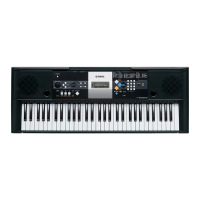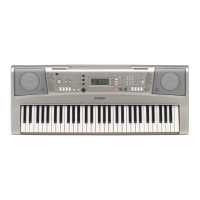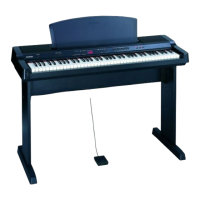Why does my Yamaha Electronic Keyboard suddenly turn off?
- CchapmanjessicaJul 29, 2025
This is likely due to the Auto Power Off function. To disable it, go to Function settings, select “Off” in the Function settings (Function Number 026).
Why does my Yamaha Electronic Keyboard suddenly turn off?
This is likely due to the Auto Power Off function. To disable it, go to Function settings, select “Off” in the Function settings (Function Number 026).
What to do if my Yamaha Electronic Keyboard turns off immediately after turning it on?
The protection circuit has been activated due to over current. Use only the specified adaptor. If the adaptor appears to be malfunctioning, stop using it immediately and have it inspected by qualified Yamaha service personnel.
Why does the sound of the Voice change from note to note on my Yamaha Electronic Keyboard?
This is normal. The AWM tone generation method uses multiple recordings (samples) of an instrument across the range of the keyboard; thus, the actual sound of the Voice may be slightly different from note to note.
Supplier's declaration of conformity with FCC Rules for digital devices.
Explanation of warning symbols used in the manual for user safety.
Safety guidelines for AC adaptor, power supply, water, fire, and not opening the instrument.
Safety guidelines regarding instrument placement, handling, and connections.
General notices, maintenance, saving data, and copyright information.
Details on the owner's manual and downloadable online materials.
Instructions for using AC adaptor or batteries for power.
Steps to turn the instrument on/off, standby mode, and manage auto power off.
Overview of buttons, dials, and switches on the instrument's front panel.
Description of audio and pedal jacks on the rear panel.
Explanation of display icons and how to select voices, songs, and styles.
How to select and play various instrument sounds.
Instructions for splitting the keyboard for simultaneous play by two people.
Guide to selecting and playing the instrument's built-in songs.
Using the interactive lesson function for practicing songs.
How to activate and use the auto accompaniment feature with styles.
Methods for playing chords to control accompaniment based on fingering type.
Using the quiz feature for ear training and pitch development.
Instructions for recording your own musical performances as user songs.
Connecting smartphones and other audio sources to the instrument.
Connecting audio output devices like headphones and speakers.
Introduction to the function settings and how to access them.
Details on effect, quiz, metronome, lesson, duo, demo, and battery functions.
Addresses issues like no sound, power interruptions, and unexpected behavior.
Details on dimensions, weight, keyboard, voices, effects, and connectivity.
Explains warranty coverage, exclusions, and procedures for obtaining service.
Provides information for customers in the European Economic Area and Switzerland.
Lists contact details for Yamaha support and distributors worldwide.
Supplier's declaration of conformity with FCC Rules for digital devices.
Explanation of warning symbols used in the manual for user safety.
Safety guidelines for AC adaptor, power supply, water, fire, and not opening the instrument.
Safety guidelines regarding instrument placement, handling, and connections.
General notices, maintenance, saving data, and copyright information.
Details on the owner's manual and downloadable online materials.
Instructions for using AC adaptor or batteries for power.
Steps to turn the instrument on/off, standby mode, and manage auto power off.
Overview of buttons, dials, and switches on the instrument's front panel.
Description of audio and pedal jacks on the rear panel.
Explanation of display icons and how to select voices, songs, and styles.
How to select and play various instrument sounds.
Instructions for splitting the keyboard for simultaneous play by two people.
Guide to selecting and playing the instrument's built-in songs.
Using the interactive lesson function for practicing songs.
How to activate and use the auto accompaniment feature with styles.
Methods for playing chords to control accompaniment based on fingering type.
Using the quiz feature for ear training and pitch development.
Instructions for recording your own musical performances as user songs.
Connecting smartphones and other audio sources to the instrument.
Connecting audio output devices like headphones and speakers.
Introduction to the function settings and how to access them.
Details on effect, quiz, metronome, lesson, duo, demo, and battery functions.
Addresses issues like no sound, power interruptions, and unexpected behavior.
Details on dimensions, weight, keyboard, voices, effects, and connectivity.
Explains warranty coverage, exclusions, and procedures for obtaining service.
Provides information for customers in the European Economic Area and Switzerland.
Lists contact details for Yamaha support and distributors worldwide.
| Pad color | White |
|---|---|
| Knobs color | Black |
| Control type | Buttons, Rotary |
| Number of knobs | 1 |
| Keyboard number of keys | 61 |
| MIDI-keyboard number of keys | 61 keys |
| Interface | - |
| DC-in jack | Yes |
| Product color | Black, White |
| Sound effects | Chorus, Reverberation |
| Volume control | Rotary |
| Compatible products | PA-130, PA-3C, L3C, FC5, FC4A, HPH-50, HPH-100, HPH-150 |
| Sound effects quantity | 17 |
| Maximum polyphony (notes) | 32 |
| Music memory capacity (songs) | 112 |
| Display type | LCD |
| Battery type | AA |
| Input voltage | 12 V |
| Power source type | Battery, DC |
| Power consumption (typical) | 6 W |
| Number of batteries supported | 6 |
| Batteries included | No |
| Depth | 317 mm |
|---|---|
| Width | 940 mm |
| Height | 104 mm |
| Weight | 4000 g |











